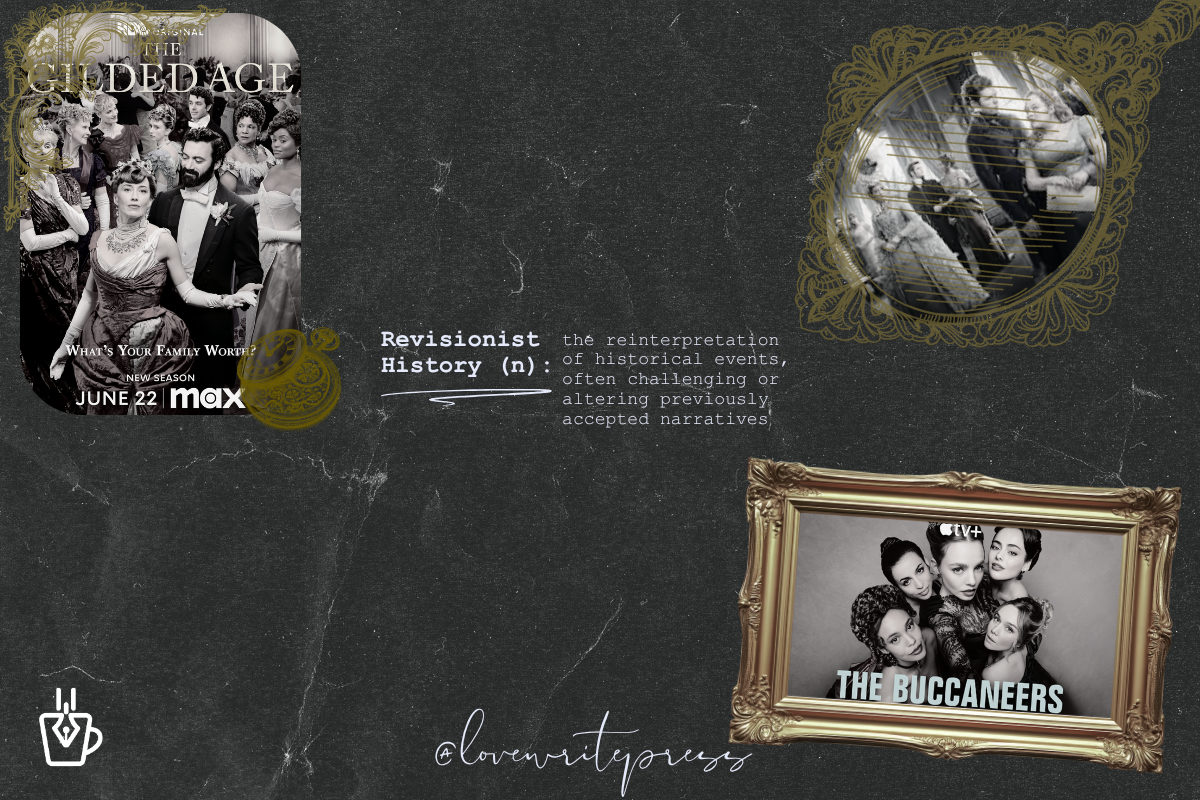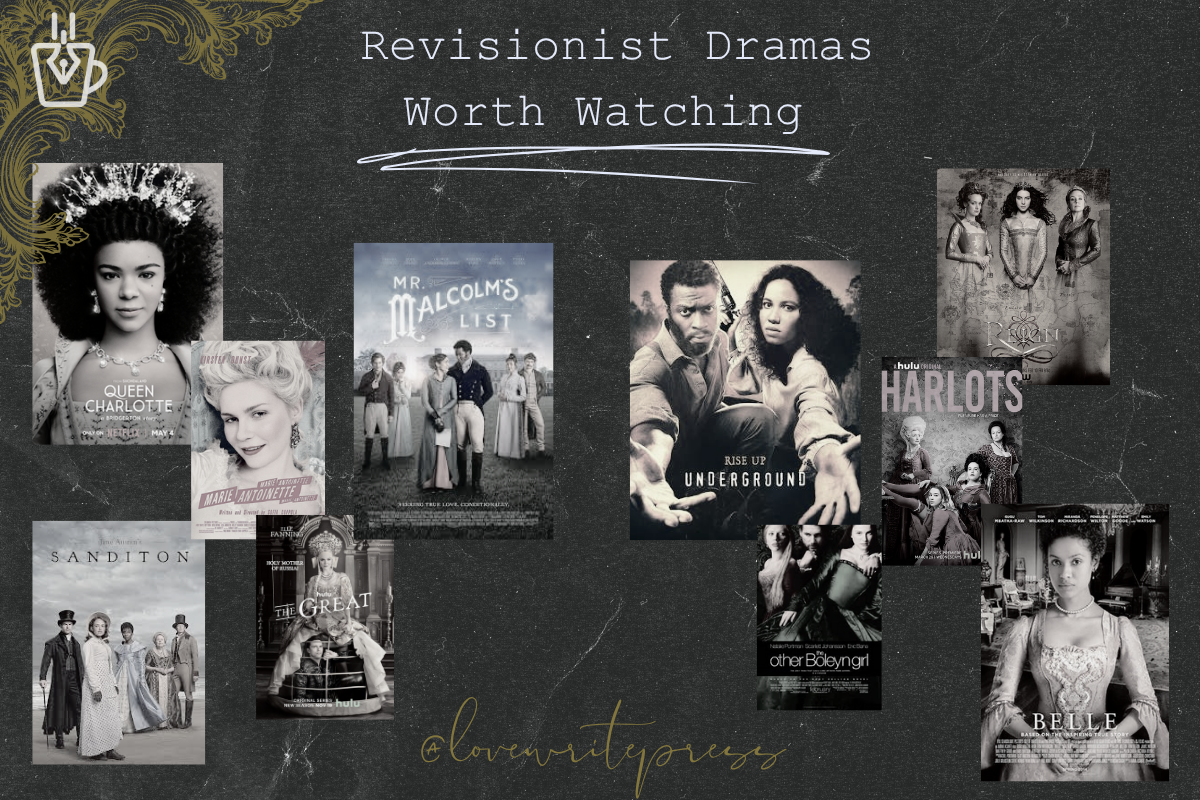The Case for Revisionist History
On Gilded Age, Buccaneers and the Lessons of the PastThe second season of Buccaneers, Apple TV’s period drama following five young ladies of marriageable age just ended its beautifully tailored, adulterous, roller coaster of drama and every single moment of it was worth the watch, to say the least. If you enjoyed this show, you probably also were a fan of The Gilded Age and Bridgerton, just a couple of the many revisionist historical dramas to hit the airwaves in recent years.
Revisionist History (n): the reinterpretation of historical events, often challenging or altering previously accepted narratives
Buccaneers , like one of many recent shows including Netflix’s Bridgerton, HBO’s Gilded Age, and Hulu’s The Great — boasts a multiracial cast and a plot line that elevates, expands or in some cases completely reimagines well-known historical figures or periods. From incorporating modern music to re-envisioning fashion, these shows shine a new, positive light on moments of history that brought about some of the ugliest legacies in our modern time.
Bridgerton, for its part, takes place roughly between the years of 1813 and 1827, just a few years before Great Britain actually abolished slavery in 1833. The way the folks over at Shondaland imagine it though, society integrated generations before, around 1761, years before the United States was even created, with the marriage of Queen Charlotte, a queen actually believed by some to have African ancestry, to King George III.
Bridgerton imagines the past world with the moral compass of today. The simple act of bringing modern morals into the past resonated with viewers so thoroughly it made it one of Netflix’s most watched shows when it premiered in 2020. While the show focuses primarily on the world of the elites, we also get to see the grimier sides of London through the eyes of the shopkeepers, newsboys, printers and our favorite boxer, Will.
Both the Gilded Age and Buccaneers follow the example of Bridgerton, featuring multiracial casts in high society settings. But that’s about where the similarities end.
Whereas Bridgerton has had multiple explainers detailing the transformative world building that makes up its multiracial 19th century world, The Gilded Age barely changes any historical facts other than names, and sometimes they don’t even change that. One of the most fascinating things about it in fact is that it’s so accurate. It sheds light on lesser known, but no less true, aspects of the era, including some of the scandals. In some episodes, it’s like a centuries-old gossip rag has come to life.
Set in the decades following the American Civil War when American industry was booming, but most Americans, Black and white, were living in squalor, The Gilded Age paints a startling picture of the wealth divide that persists today. Like its British counterpart Downtown Abbey, its an above stairs — below stairs drama that follows the lives of wealthy aristocrats and the people who serve them, but unlike Downtown Abbey, The Gilded Age also explores the uniquely American aspect of race.
The show delves into the lives of Black Americans post slavery, particularly those who lived lives comparable to those of high society white Americans. Season three in particular digs deeper into the world of the Black elite, showcasing a family that boasts graduates of elite New England colleges and had put slavery into their families’ rearview generations before emancipation. In this season the family of main character Peggy Scott and particularly her father who was himself enslaved, comes into contrast with that of Peggy’s suitor, Dr. Kirkland, whose family had not been enslaved for generations and whose mother, Elizabeth Kirkland (played by Phylicia Rashad) was the descendant of a Revolutionary War veteran. The friction between the two families and their class distinctions is a feature of Black American life not often remarked upon.
Aside from fascinating moments in the lesser known world of the Black elites, the show also demonstrates how the smaller world of New York elites was in staunch contrast to other areas of the country, like the “wild” west, much of which wasn’t fully incorporated into the United States yet, and the segregated south, which was working to re-entrench the racial caste system in a post-Reconstruction world. The new season has also shed light on the fight for women’s suffrage, allowing viewers a realistic glimpse into an oft-romanticized past.
The Gilded Age offers a real-world view of the past as it was, in contrast to Bridgerton’s moral reimagining. Buccaneers does something all together different, though no less entertaining to watch.
Despite its multiracial cast, the show makes no attempt to explain how these high society circles, which were very much segregated in real life, came to be integrated on the show. Instead, we get a very Marie Antoinette-esque (the movie, not the real life figure) delving into the excess and debauchery of the Gilded Age with girls who are far more feminist than they ever would have been in that era. We see the girls freely choosing lovers (in some cases of the same sex) and speaking out in a way that draws a stark contrast between Americans and the British, which of course is a central tenet of the show (it says it in the theme song after all).
As the show is based on a novel that this author hasn’t read, I can only assume that the plot, the love triangles, marriages, and such remain much the same as the book. In my view, the revisionist aspect of the show lives in the casting choices (one of the main love interests in biracial, as is one of the female main characters), the attitudes of the women on the show, who center their own desires over their duties as wives, and the social commentary, which clearly comes into view in season two, as the eras restrictions on women are more clearly outlined and rebelled against by the main characters. In this show, we get to imagine ways in which women may have been heroes in their own right, rather than damsels awaiting the aid of a prince (or Duke in this instance). We see women in roles of influence and power, bucking against the societal norms around marriage, divorce, adultery and the like. Through it all, we’re still regaled with love stories, both romantic and platonic.
The historical eras featured in these shows in real life, featured racial discrimination, colonization, brutality and the plunder of indigenous communities. In many ways, it was nothing to be proud of. However, in the tradition of Hamilton and the other multiracial historical dramas that came before, these shows allow us to suspend the valid critiques of these historical moments and have fun with them. We’re able to, if only for an hour at a time, see the joy, creativity and progress, that undoubtedly existed in this time, even if that’s not what’s been taught in our history classes.
Other Revisionist Movies and TV Shows worth watching.
In each show, we see a reinterpretation of history that brings more of humanity into the storyline. It’s not so much “his”story, as it its everyone’s story, which of course is exactly as it should be.
The season finale of Buccaneers is now streaming on Apple TV and the season finale of The Gilded Age will air on Sunday, August 10, 2025 at 9:00pm on HBO.


